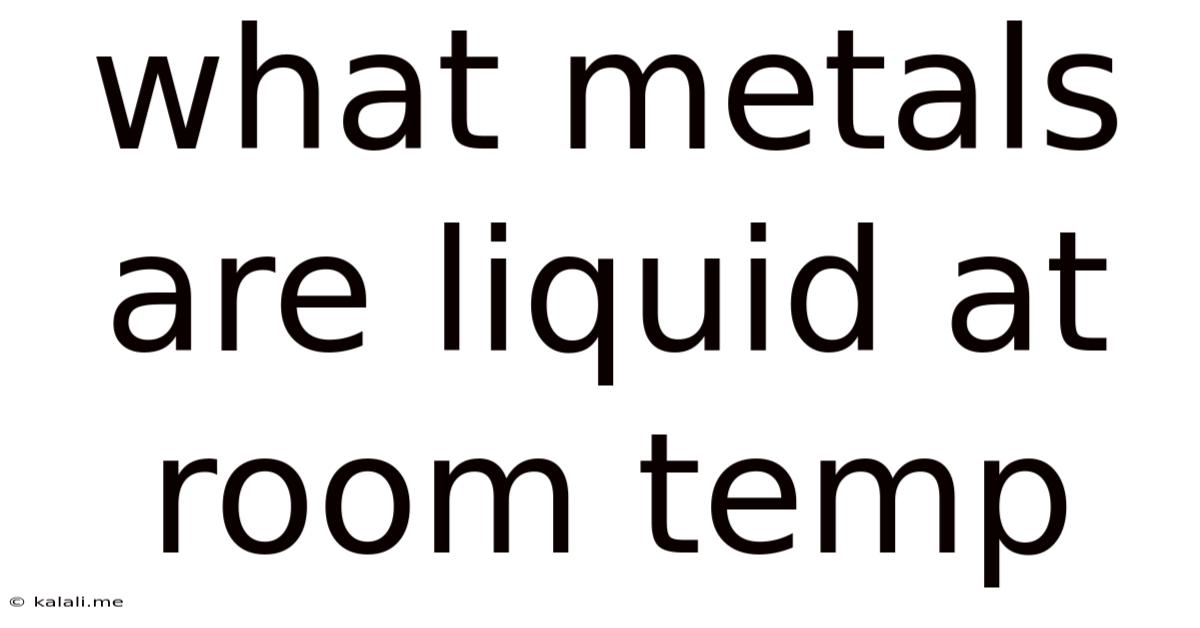What Metals Are Liquid At Room Temp
Kalali
Jun 11, 2025 · 3 min read

Table of Contents
What Metals Are Liquid at Room Temperature? A Deep Dive into Low-Melting-Point Metals
Meta Description: Discover the fascinating world of metals that remain liquid at room temperature. This article explores the properties, applications, and unique characteristics of these unusual elements. Learn about mercury, caesium, francium, and gallium – the only metals liquid at or near room temperature.
Finding metals that exist as liquids at room temperature is surprisingly rare. While most metals are known for their solidity and high melting points, a small handful defy this expectation. Let's delve into the unique properties and applications of these exceptional elements.
The Liquid Metal Club: Members Only
Only a few metals melt at or near room temperature (defined as 20-25°C or 68-77°F). These metallic outliers are primarily characterized by their relatively weak metallic bonds, leading to lower melting points compared to their counterparts. Here are the primary members of this exclusive club:
-
Mercury (Hg): Arguably the most well-known liquid metal, mercury boasts a melting point of -38.83°C (-37.89°F). Its liquid nature, high density, and unique ability to form amalgams (alloys with other metals) have led to its historical use in thermometers, barometers, and other scientific instruments. However, its extreme toxicity has significantly curtailed its usage in recent years, with safer alternatives now preferred. Mercury's toxicity is a significant factor impacting its handling and disposal, demanding strict safety protocols.
-
Caesium (Cs): This highly reactive alkali metal melts at a mere 28.44°C (83.19°F), making it liquid at slightly above room temperature. Its low ionization energy makes it extremely reactive with air and water, producing explosive reactions. Consequently, caesium requires careful handling and is primarily used in specialized applications such as atomic clocks and as a getter in vacuum tubes due to its high reactivity.
-
Francium (Fr): A radioactive element, francium has a melting point estimated to be around 27°C (81°F). However, due to its extreme rarity and short half-life, it's exceptionally difficult to study its properties in detail. It exists only in trace amounts and primarily used in scientific research.
-
Gallium (Ga): While not strictly liquid at room temperature, gallium's low melting point of 29.76°C (85.57°F) means it liquefies slightly above. This fascinating metal is known for its ability to melt in the palm of your hand, making it a popular element in demonstrations and educational settings. Beyond its melting point, gallium's unique properties, including its high boiling point and its ability to wet many materials, lend themselves to numerous applications in electronics and semiconductors.
Why Are Some Metals Liquid at Room Temperature?
The reason behind the low melting points of these metals lies in their atomic structures and the strength of their metallic bonds. Weaker metallic bonds require less energy to overcome, leading to lower melting points. Factors influencing bond strength include atomic size, number of valence electrons, and electron configuration. The unique electronic configurations of these metals contribute to their relatively weak interatomic forces.
Applications of Liquid Metals
Although the applications are limited by toxicity or reactivity concerns in some cases, liquid metals find specialized uses in various fields:
-
Mercury: Despite its toxicity, it's still used in specific niche applications where safer alternatives are unavailable or impractical.
-
Caesium: Primarily used in atomic clocks and vacuum tubes.
-
Gallium: Widely used in semiconductors, LEDs, and other electronic components due to its unique properties.
Liquid metals represent a fascinating niche within the world of materials science. Their unique properties, though often challenging to work with, continue to intrigue scientists and engineers, leading to the development of innovative technologies. Further research into their potential applications may unlock even more exciting possibilities in the future.
Latest Posts
Latest Posts
-
Did You Hear About The Antelope Who Was Getting Dressed
Jul 01, 2025
-
How Many Units Are In 1 Ml
Jul 01, 2025
-
Write An Equation For These Two Complementary Angles
Jul 01, 2025
-
How Do You Beat Bloxorz Level 7
Jul 01, 2025
-
How Old Are You If Your Born In 1992
Jul 01, 2025
Related Post
Thank you for visiting our website which covers about What Metals Are Liquid At Room Temp . We hope the information provided has been useful to you. Feel free to contact us if you have any questions or need further assistance. See you next time and don't miss to bookmark.